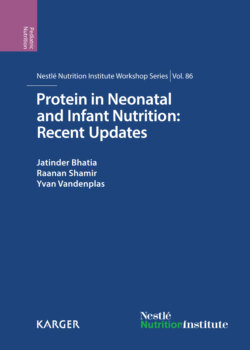Читать книгу Protein in Neonatal and Infant Nutrition: Recent Updates - Группа авторов - Страница 28
На сайте Литреса книга снята с продажи.
Partially and Extensively Hydrolyzed Formulas
ОглавлениеThere is no general agreement on unique standards to specifically define partially hydrolyzed formula (pHF) and eHF, but the MW and percentage of the peptide fragments are generally used to classify the formulas into pHF or eHF. Both pHF and eHF consist of a wide range of peptide sizes. A pHF contains peptides with a MW generally <5 kDa, ranging from 3 to 10 kDa, with some commercial pHF containing 18% of peptides over 6 kDa [16]; an eHF should contain only peptides that have an MW <3 kDa [17] but usually has more than 90% of peptides <3 kDa, with 1-5% of peptides >3.5 kDa [16]. In contrast, the MW of whole CMP ranges from 14 kDa (α-Lac) to 24 kDa (Cas) and up to 67 kDa (BSA) [7]. The weight of peptides has immune and clinical relevance because the ‘bigger’ the peptides the ‘more allergenic’ they can be. Peptides >6 kDa and predominantly >10 kDa frequently act as allergens [18]. However, allergenic peptides of 3-5 kDa MW have been described more than 20 years ago [19]. For peptides <3 kDa, there is no agreement about the lowest MW cutoff for allergenicity [20]. In vitro assays showed reaction of sera of allergic patients to peptides of estimated MWs of 500-600 Da [21, 22]. Disagreement found in the literature about this issue may be due to the hydrolysis process of proteins used and the sensitivity of patients against the allergen [20].
pHFs are developed with the aim of minimizing the number of sensitizing epitopes within milk proteins, while at the same time retaining peptides with sufficient size and immunogenicity to possibly stimulate the induction of oral tolerance. Because pHF contains large CM peptides that can cause severe reactions in CMA patients, pHF is not recommended for the treatment of CMA [1-3]. eHFs are extensively hydrolyzed in order to destroy allergenic epitopes, maintaining the nitrogen in the form of free amino-acid formulas (AAFs) or very small peptides which are indicated in treatment but can as well be used in prevention. Which type induces the best oral tolerance in infants, pHF or eHF, is still debated. The MW profile of proteins only enables to differentiate protein characteristics of formulas, but does not clearly determine the allergenic properties and clinical response [18].
Because of the different responses to whey or Cas allergens, children who do not tolerate whey-based eHF (eHF-W) may be able to tolerate Cas-based eHF (eHF-C) and the other way round [23].
Commercial HFs vary in protein source (e.g. Cas, whey, soy or rice), method and percentage of hydrolysis, content of β-Lg or other proteins, content of nonprotein components (such as lactose, DHA, nucleotides or probiotics) and osmolarity implying that the immune and clinical ‘results’ of one formula cannot be transferred to another.
